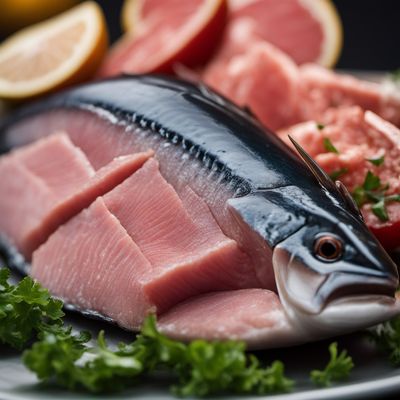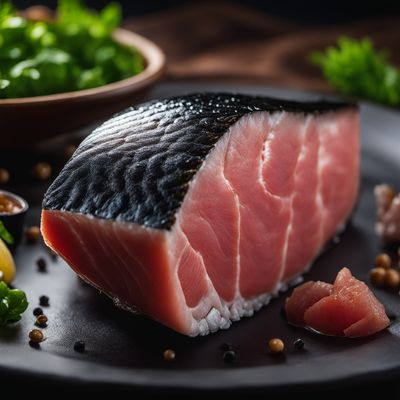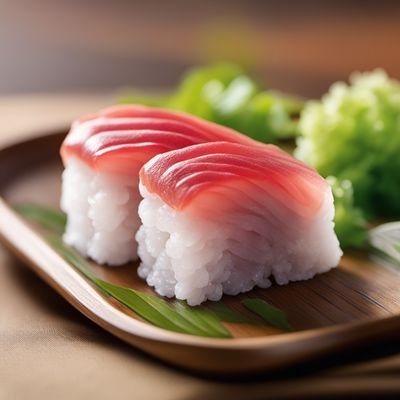
Ingredient
Tuna, yellowfin
"The Jewel of the Sea: Exploring the Delights of Yellowfin Tuna"
Yellowfin tuna, also known as Thunnus albacares, is a species of tuna found in tropical and subtropical oceans worldwide. It is characterized by its sleek, torpedo-shaped body, metallic blue-black back, and vibrant yellow fins. With a firm and meaty texture, yellowfin tuna offers a mild, slightly sweet flavor that is often compared to beef. Its flesh ranges from pale pink to deep red, depending on the age and diet of the fish. This ingredient is highly sought after for its versatility, making it suitable for a wide range of culinary applications.
Origins and history
Yellowfin tuna has a rich history dating back centuries. It is believed to have originated in the warm waters of the Pacific Ocean, particularly around the coasts of Southeast Asia and the Hawaiian Islands. Throughout history, yellowfin tuna has played a significant role in the diets and cultures of various coastal communities. It has been a staple in traditional Japanese cuisine, where it is highly valued for its use in sushi and sashimi. Today, yellowfin tuna is harvested in many regions around the world, including the Atlantic Ocean, Indian Ocean, and Mediterranean Sea.
Nutritional information
Yellowfin tuna is a nutritional powerhouse, packed with essential nutrients. It is an excellent source of high-quality protein, providing all the essential amino acids needed for optimal health. Additionally, it is rich in omega-3 fatty acids, which promote heart health and reduce inflammation. Yellowfin tuna is also a good source of vitamins B12 and D, as well as minerals like selenium and potassium. A 3-ounce serving of yellowfin tuna contains approximately 109 calories, making it a lean and nutritious choice.
Allergens
Yellowfin tuna is a fish, and individuals with fish allergies should exercise caution when consuming this ingredient.
How to select
When selecting yellowfin tuna, look for firm, glossy flesh that springs back when pressed lightly. The color should be vibrant, ranging from pink to deep red, depending on personal preference. Avoid any fish with a strong fishy odor or signs of discoloration. If purchasing from a fish market or supermarket, ensure that the fish is properly stored on ice to maintain its freshness.
Storage recommendations
To maintain the freshness and quality of yellowfin tuna, it is best to store it in the refrigerator at a temperature between 32°F and 38°F (0°C and 3°C). If the fish is whole, it should be wrapped tightly in plastic wrap or placed in an airtight container. If the fish is already filleted, it can be stored in a sealed plastic bag. It is important to consume yellowfin tuna within 1-2 days of purchase for optimal flavor and texture.
How to produce
Yellowfin tuna is typically caught by commercial fishing vessels using various methods such as longlining, purse seining, or pole and line fishing. It requires specialized equipment and knowledge to catch yellowfin tuna on a large scale. However, for those interested in recreational fishing, it is possible to catch yellowfin tuna with the right equipment, such as a sturdy fishing rod and reel, in areas where it is abundant.
Preparation tips
Yellowfin tuna can be prepared in various ways, depending on personal preference. For raw preparations like sushi or sashimi, it is crucial to use the freshest, highest-quality fish. When searing yellowfin tuna, it is best to cook it briefly over high heat to maintain its tender texture. Marinating the fish in a mixture of soy sauce, ginger, and garlic can enhance its flavor. Yellowfin tuna also pairs well with citrus fruits, herbs like cilantro or basil, and spices such as black pepper or chili flakes. It can be grilled, baked, or even used in salads or ceviche.
Culinary uses
Yellowfin tuna is a versatile ingredient that can be used in a variety of culinary applications. It is commonly used in sushi, sashimi, and poke bowls, where its fresh and delicate flavor shines. Yellowfin tuna can also be seared and served as a main course, either on its own or accompanied by sauces or glazes. It is a popular choice for grilling, as its firm texture holds up well to high heat. Additionally, yellowfin tuna can be used in salads, sandwiches, or pasta dishes, adding a burst of flavor and protein.
Availability
Yellowfin tuna is commonly available in regions with access to coastal waters, including countries such as Japan, the United States, Mexico, Spain, Italy, and Australia.
More ingredients from this category

Tuna, bluefin (generic)
The Jewel of the Sea: Exploring the World of Bluefin Tuna

Albacore
The Mighty Albacore

Tuna, longtail
The Ocean's Swift Hunter

Tuna, skipjack
The Ocean's Bounty

Tuna, blackfin
The Ocean's Delicacy: Exploring the Richness of Blackfin Tuna

Tuna, bigeye
The Mighty Bigeye Tuna

Bullet tuna
The Speedy Predator
Recipes using Tuna, yellowfin

Iwakunizushi - Japanese Delight
Sakura Sushi - A Blossoming Japanese Delicacy

Molecular Sushi
Sushi Reimagined: A Molecular Gastronomy Twist

Buri daikon with Alpine twist
Alpine-inspired Buri Daikon: A Hearty Delight from the Mountains

Kaisendon - Japanese Seafood Rice Bowl
Ocean Delight: A Flavorful Japanese Seafood Rice Bowl

Buri Nigiri Sushi
Golden Delight Sushi: A Taste of Japan's Finest

Cantabrian Stuffed Peppers
Delicious Cantabrian Peppers: A Twist on Stuffed Peppers

Fresh and Flavorful Sashimi Delight
Oceanic Symphony: A Celebration of Japanese Sashimi

Haute Cuisine Sushi
Elevated Sushi Delights: A Haute Cuisine Twist

Hamachi Nigiri Sushi
Sunset Delight Sushi: A Burst of Freshness and Elegance

Circassian-style Hamachi Nigiri Sushi
Golden Delight: Circassian-inspired Hamachi Nigiri Sushi

Peranakan-inspired Tricolore Risotto
Nyonya Fusion Risotto: A Harmony of Colors and Flavors